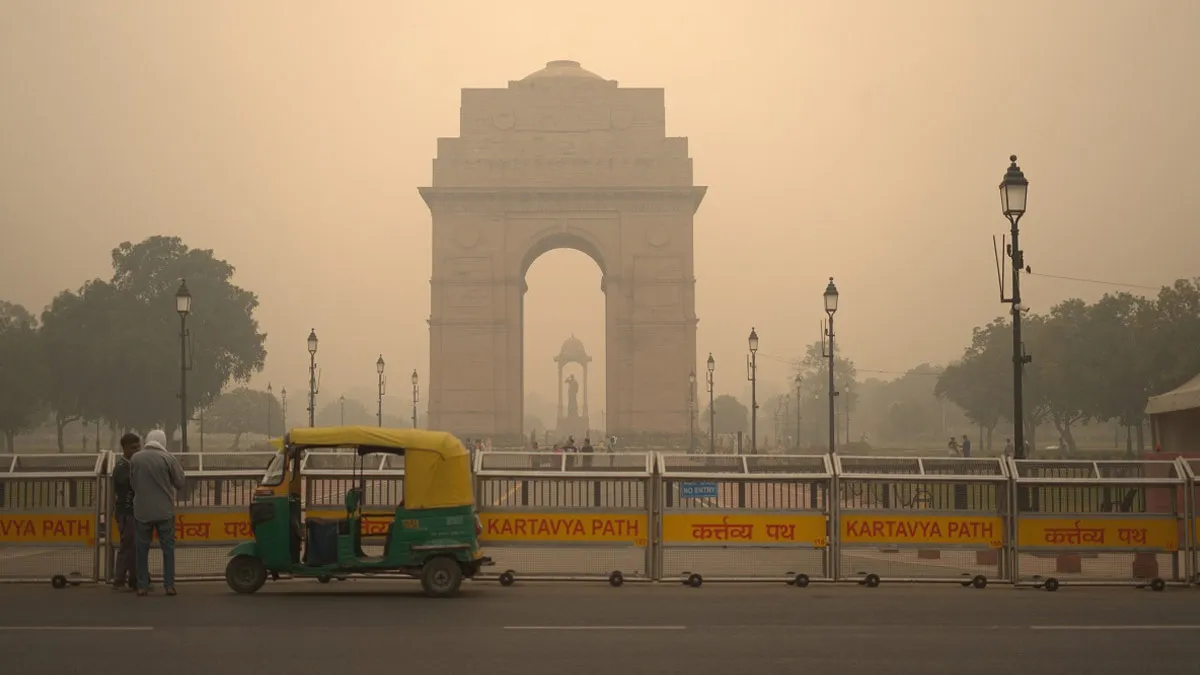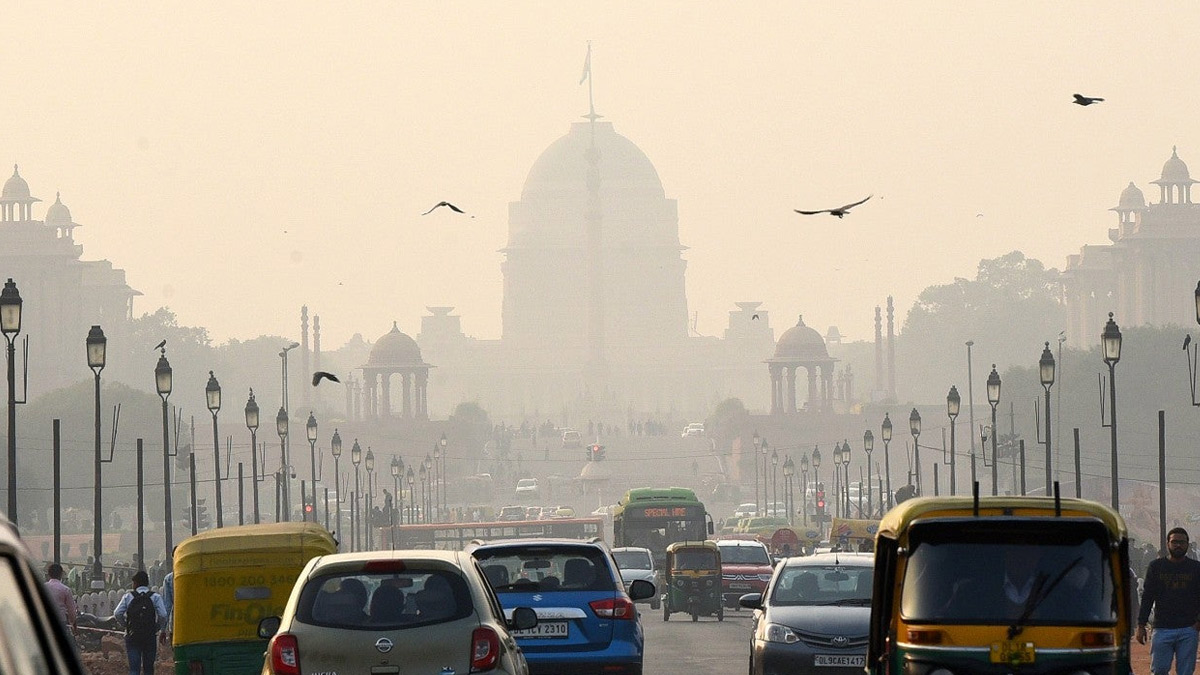
Delhi’s battle with air pollution has once again intensified as the Air Quality Index (AQI) hit hazardous levels, affecting the entire National Capital Region (NCR). On Tuesday, the Central Pollution Control Board (CPCB) reported that the AQI had climbed to a concerning 352, indicating severely compromised air quality. The pervasive smog not only reduces visibility but also presents serious health risks for residents.
Table of Content:-
Current AQI Status: A Worsening Scenario
The air quality in Delhi-NCR fluctuated between ‘very poor’ and ‘severe’ categories. Specific areas like Wazirpur, Jahangirpuri, and Anand Vihar recorded AQI levels exceeding 400, which are classified as ‘severe.’ These areas, with AQIs of 421, 419, and 403 respectively, highlight the alarming rise in pollution. Other areas such as Ashok Vihar, Burari, and Pusa recorded AQI readings close to 400, hovering in the ‘very poor’ range.
The areas with relatively lower readings, such as Lodhi Road, showed an AQI of 235, which, while still concerning, is lower than other regions but remains far from safe. As Delhi’s pollution season worsens, its AQI is one of the highest among Indian cities, joined by regions like Ghaziabad and Sonipat in the ‘very poor’ category, further indicating the expansive nature of this pollution crisis.

Weather Conditions Worsening Air Quality
Meteorological conditions are significantly aggravating the air quality crisis in Delhi-NCR. Experts attribute the persistent smog to factors such as low wind speeds and high humidity. Normally, wind disperses pollutants, carrying them away from densely populated areas, but the calm conditions currently prevailing over Delhi are allowing pollutants to stagnate. With low winds and high moisture levels, pollutants are trapped near ground level, preventing the smog from clearing.
This situation is expected to persist as weather conditions remain largely unchanged, potentially causing further degradation of air quality in the coming days. Without a significant shift in weather patterns, pollution levels are unlikely to improve swiftly.
Also Read: Canada Reports First Human H5 Bird Flu Case In British Columbia; Doctors Label It A ‘Rare Event’
Health Risks of Prolonged Exposure
Poor air quality is closely linked to severe health concerns. Individuals exposed to high levels of pollutants face a variety of symptoms, ranging from mild to severe. Common health effects include coughing, throat irritation, and breathlessness, while more severe exposure can lead to fatigue, chest pain, and exacerbation of chronic respiratory issues like asthma. Experts emphasize that long-term exposure can heighten the risk of cardiovascular diseases and respiratory conditions, particularly for vulnerable groups such as children, the elderly, and those with pre-existing health conditions.
As the city’s AQI worsens, health professionals are witnessing an increase in respiratory ailments among Delhi’s residents. Hospitals have reported more cases of asthma, bronchitis, and other pollution-related health issues. Health experts urge the public to limit outdoor activities, especially strenuous exercise, which increases the risk of inhaling more pollutants. Wearing masks, using air purifiers indoors, and monitoring air quality through mobile apps or official sources are also recommended to reduce exposure.
Government Measures and Public Response
Delhi’s pollution crisis has prompted several efforts by the government to mitigate the effects, though the impact remains to be seen. The authorities have increased monitoring of construction activities, vehicle emissions, and industrial pollutants to curb pollution sources. The Delhi government has also reintroduced the ‘Odd-Even’ vehicle scheme in previous years to reduce vehicular pollution and has been promoting the use of public transportation to reduce congestion on roads.
Despite these efforts, residents express frustration over recurring pollution problems, advocating for long-term, impactful solutions that address pollution sources. Citizens and environmental groups are calling for stricter regulations on emissions from industries and vehicles, as well as stronger policies against stubble burning, a seasonal contributor to air pollution in the region.
Also Read: Rare 'Jock Itch' Infection Linked to Sexual Activity Emerges in the US; Know All About It
What Can Residents Do?
As pollution levels remain dangerously high, residents must take proactive steps to safeguard their health. Limiting time outdoors, particularly for young children and the elderly, is advisable. Schools have also been alerted to prioritize indoor activities during periods of intense smog. For those who must go outdoors, masks designed to filter out fine particulate matter (PM2.5) are highly recommended.
Indoor air purifiers, particularly those with HEPA filters, can help improve air quality inside homes. Additionally, staying informed about daily AQI levels through government websites and apps can help residents plan their day accordingly to minimize exposure.
The Path Ahead
With pollution levels in Delhi reaching critical levels, the road to cleaner air requires both immediate actions and long-term solutions. While temporary measures like traffic restrictions and restrictions on construction help in the short term, sustainable practices, technological interventions, and stricter pollution regulations are essential for achieving lasting change.
For Delhi’s residents, the effects of air pollution are a harsh reminder of the urgent need to prioritize clean air policies, both for public health and environmental sustainability.
Also watch this video
How we keep this article up to date:
We work with experts and keep a close eye on the latest in health and wellness. Whenever there is a new research or helpful information, we update our articles with accurate and useful advice.
Current Version